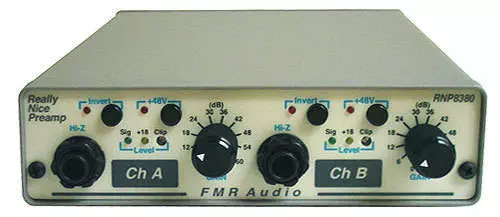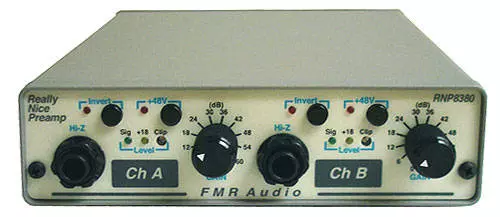FMR Audio Really Nice Preamp

Additional Photos:

The Really Nice Pre-amp, the RNP, is a 1/3 rack two channel mic pre-amp. FMR's objectives for this pre-amp were:
Relatively neutral sonics
Compatibility with the RNC/RNLA
We believe that the RNP is a good addition to any studio looking for an clean, full-sounding mic pre-amp.
WHAT'S COOL
Lots o' headroom. These days, the trend is for microphones to increase their output signal levels while reducing their output noise levels. This means either employing a front-end pad and/or increasing the headroom of a mic pre. We decided to do the latter: at unity gain, the RNP 8380 has a clip point of +27.5dBu (almost 25Volts peak-to-peak)! Even with a hefty microphone output, the RNP8380 should take what your mics have to give.
Fidelity. When designing a pre-amp, there are many ways to balance the sometimes conflicting operating constraints. Unfortunately, with the proliferation of integrated-circuit (IC) based mic pres in recent years, one of the typical casualties has been fidelity. At this point, I won't bore you with the geeky details, but I want to assure you that fidelity was not sacrificed in the RNP8380. Even though there are many mic pres that are quieter, there are very few that have the spurious-free (i.e., distortion-free) spectrum of the RNP8380. Now, more than ever, what you put into a mic pre is what you'll get out.
Ugly box. If you look beyond the RNP8380's utilitarian ugliness, you'll see that we opted to throw the money we saved in cosmetics into the quality of the audio electronics. I like having nice-looking gear as much as the next guy, but given the choice between something that sounds nice versus looks nice, the sound wins out everytime.
Really Nice Compressor (RNC) inserts. Each channel on the RNP8380 has an unbalanced send/receive jack that allow you to connect an RNC1773 using a single Tip-Ring-Sleeve (TRS) cable (per channel). With proper cabling, you could also use this feature to balance any other unbalanced piece of gear. In addition, with the right external configuration, the RNP can provide a separate +22dBu unbalanced output and a +28dBu balanced output simultaneously to allow nifty things like separate M/S decoding while tracking the M/S signal without decoding.
Balanced/unbalanced operation. Both the mic inputs and mic pre outputs are electronically balanced, differential signals. Want to run to/from unbalanced sources? No problem, the RNP automatically adjusts...no special cabling required.
Balancing an RNC. Using the above features, you can allow/provide a balanced signal to/from an RNC/RNP set.
Hi-Z DI inputs. These inputs are designed to take a source, such as a passive bass, and not "suck the tone" away from the instrument. This input features a high-impedance unbalanced 1/4" jack.
Slowly-ramping 48V supply. To reduce the chance of destroying mics connected to the RNP that can't tolerate +48V applied to them, we ramp up the +48Volts slowly just in case you accidently turn on the phantom supply with a phantom-intolerant microphone attached to the RNP. In addition, this ramp helps reduce "settling time" of the RNP's servos (see Geek Stuff below) and reduces the size of the output pops/clicks.
EMI-resistant. The pre-amp's front end includes a third-order EMI filter. It is specifically designed to attenuate RF while giving a smooth audio performance up to 200kHz. This reduces the chances that you'll have trouble with RF interfering with the RNP's operation even at high-gain levels. When used with a nominal 150 Ohm balanced source, this filter yields exceptional audio performance.
Output mutes. During phantom engagement/disengagement and DI/mic switching, we momentarily mute the output signals to reduce output pops & clicks that may otherwise annoy you and others. This mute actually occurs before the insert send signal, so even devices connected to the insert are spared large pops & clicks.
Stepped gain control. To allow precise gain-setting between multiple channels, we're using a Grayhill 12 position switch to set the RNP's gain.
Phase inversion control. This is fairly standard stuff to allow you to accommodate any phase problems due to things like system cabling, etc.
Precision metering. Three LEDs are provided for metering each channel (signal presence, +18dBu and CLIP). In addition, the clip LED trips at 1dB below actual clip and stays on for 3 seconds to make signal-chain troubleshooting easier. The metering is digitally-calibrated and driven by the internal microprocessor.
Flexible power supply requirements. The RNP will run off of either AC or DC as long as the voltage range is within 9-12V (and has a current capacity of at least 1.5Amps). Polarity of the wallwart connection is unimportant so that you don't have to worry about that detail either. In addition, if you happen to connect a wallwart that doesn't have enough oomph to power the RNP (like the RNC's wallwart), the RNP will tell you by periodically flashing it's front panel LEDs.
Geek stuff. An internal microprocessor provides control and monitoring of many RNP internal activities: power supply operation, source (mic/DI) selection, precision metering, push button control and phantom voltage control. The preamp itself is a unique, full Class A self-biasing-fully differential-DC servoed-transimpedance-100MHz GBP-instrumentation amp with an input impedance of 5k. The RNP's maximum level is +28dBu (differential mode) with an EIN of -120dB. High common-mode impedances help reduce the effect of interfering noise sources. Both phantom coupling caps and gain port voltages are independently servoed.
Q & A
Reviews

Protect your investment with the Long & McQuade Performance Warranty
A warranty can be a very important factor when making a buying decision. Because repairs can be very expensive in terms of parts and labour costs, manufacturers usually only provide one year limited warranties that generally only cover items that malfunction due to a manufacturer’s defect. With an important purchase such as a musical
instrument or piece of studio gear, however, many people want to have the peace of mind in knowing that their investment will be protected should the product no longer be performing at 100%.
Because of this, Long & McQuade provides our customers with a FREE one-year Performance Warranty on most of our products. The Long & McQuade Performance Warranty supplements the manufacturer’s warranty to ensure that our customers receive complete “no hassle” warranty coverage within their first year.
How does the Long & McQuade Performance Warranty differ from most manufacturers' warranties?
- Performance Guarantee: Normal wear and tear is covered, so your product will be performing as well as the day you purchased it for the entire duration of the coverage. Band and Orchestral Performance Warranty does not include replacing pads or cleaning for woodwind instruments, unless deemed necessary by our repair staff. Ultrasonic cleaning for brass instruments will be provided if deemed necessary by our repair staff, but is not routinely offered under the Performance Warranty.
- Product Replacement: If your product cannot be fixed or costs too much to fix, we will replace it with the equivalent model for no additional charge. If this is not possible, a full refund will be provided.
- No Lemon Policy: Your product will be replaced should the same problem occur multiple times.
- Convenient: Easy drop off and pick up of the product at any Long & McQuade location.
- Guitar Setup: Guitars purchased at Long & McQuade come with 1 free setup, to be redeemed within 1 year for new guitars and 90 days for used guitars.
- Loaners Available: A loaner product may be given while the product is being repaired.
- Power Surge Protection: Your product is covered even if damaged from a power surge.
- Accessory Coverage: Any peripheral devices or accessories that come with your product (i.e. foot pedal, case) are also covered.
- Commercial Use Coverage: Music and recording professionals who purchase gear for “heavy-use” commercial purposes will still be covered.
Long & McQuade reserves the right to restrict the purchase of additional years of Performance Warranty. Used products come with a 3-month Long & McQuade Performance Warranty. Some products (i.e. computers, software, cymbals and other items) are covered only by the manufacturer‘s warranty. Consumables (i.e. strings, reeds, drum sticks, batteries, tubes, cross faders) are excluded as they are designed to be replaced. Cosmetic Damage, Accidental Damage, or problems caused by Humidity or Temperature Issues are not covered. Speakers damaged by overpowering are generally not covered. Our coverage does not provide compensation for loss of use. As of June 2018 the Performance Warranty is no longer transferable. The warranty is only valid in Canada.
Purchasing additional years of coverage
Some manufacturers provide warranties for longer than 1 year; however, these are usually limited warranties that do not provide the same coverage as the Long & McQuade Performance Warranty. Customers interested in more complete and convenient (but not necessarily longer) coverage are still able to purchase additional years of the Performance Warranty.
If you are interested in receiving this coverage for longer than one year, you have the option of purchasing additional years of the Performance Warranty. The pricing is as follows:
- NEW products: Starting at 4% of the current new selling price to double the warranty from 1 year to 2 years. Starting at 4% for each additional year.
- USED products: Starting at 4% of the current new selling price to increase the warranty from 3 months to 1 year. Starting at 4% for each additional year.
- GUITARS: 4% of the current new selling price to double the warranty from 1 year to 2 years. 4% for each additional year. $45 maximum. An additional free setup is not included with additional purchased years of Performance Warranty.
- BAND and ORCHESTRAL instruments: 4% of the current new selling price to double the warranty from 1 year to 2 years. 4% for each additional year.






